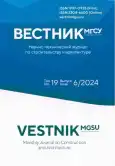Анализ прочностных и теплопроводных характеристик слоистых балок, состоящих из массива дерева и теплоизоляционного материала
- Авторы: Панова М.С.1, Татусь Н.А.1,2
-
Учреждения:
- Национальный исследовательский Московский государственный строительный университет (НИУ МГСУ)
- Институт машиноведения им. А.А. Благонравова Российской академии наук (ИМАШ РАН)
- Выпуск: Том 19, № 6 (2024)
- Страницы: 982-990
- Раздел: Строительное материаловедение
- URL: https://bakhtiniada.ru/1997-0935/article/view/259924
- ID: 259924
Цитировать
Полный текст
Аннотация
Ключевые слова
Об авторах
М. С. Панова
Национальный исследовательский Московский государственный строительный университет (НИУ МГСУ)
Email: panova.mariya1999@gmail.com
Н. А. Татусь
Национальный исследовательский Московский государственный строительный университет (НИУ МГСУ); Институт машиноведения им. А.А. Благонравова Российской академии наук (ИМАШ РАН)
Email: nikalet@mail.ru
ORCID iD: 0000-0003-1748-9976
Список литературы
- Zaid N.Z.M., Rejab M.R.M., Mohamed N.A.N. Sandwich structure based on corrugated-core : a review // MATEC Web of Conferences. 2016. Vol. 74. P. 00029. doi: 10.1051/matecconf/20167400029
- Комаров В.А., Павлова С.А. Учет требований жесткости при проектировании трехслойных конструкций панелей пола самолета из высокопрочных композиционных материалов // Вестник Самарского университета. Аэрокосмическая техника, технологии и машиностроение. 2021. Т. 20. № 2. С. 45–52. doi: 10.18287/2541-7533-2021-20-2-45-52. EDN SUXWWR.
- Stefan A., Pelin G., Pelin C., Petre A., Marin M. Manufacturing process, mechanical behavior and modeling of composites structures sandwich panel // Incas Bulletin. 2021. Vol. 13. Issue 1. Pp. 183–191. doi: 10.13111/2066-8201.2021.13.1.19
- Павлычева Е.А., Пикалов Е.С. Современные энергоэффективные конструкционные и облицовочные строительные материалы // Международный журнал прикладных и фундаментальных исследований. 2020. № 7. С. 76–87. EDN TJASPQ.
- American Institute of Timber Construction. Timber construction manual. 2012. doi: 10.1002/9781118279687
- Hayward P.A. Timber-connector construction // Journal of Fluids Engineering. 1937. Vol. 59. Issue 5. Pp. 457–460. doi: 10.1115/1.4020487
- Bader T., Ormarsson S. Modeling the mechanical behavior of wood materials and timber structures // Springer Handbook of Wood Science and Technology. 2023. Pp. 507–568. doi: 10.1007/978-3-030-81315-4_10
- Kuzman M., Oblak L., Vratuša S. Glued laminated timber in architecture // Drvna Industrija. 2010. Vol. 61. Issue 3.
- Gao S., Xu M., Guo N., Zhang Y. Mechanical properties of glued-laminated timber with different assembly patterns // Advances in Civil Engineering. 2019. Pp. 1–13. doi: 10.1155/2019/9495705
- Хошимова Ф.Ф., Панфилов Д.В., Поликутин А.Э. Расчет деревянных мостовых брусьев, армированных лентой из углеродного волокна, при циклических воздействиях // Научный журнал строительства и архитектуры. 2023. № 3 (71). С. 22–30. doi: 10.36622/VSTU.2023.3.71.002. EDN JOWSQH.
- Kopecky P., Staněk K., Bureš M., Richter J., Tywoniak J. Experimental investigations of wooden beam ends in masonry with internal insulation // Energy Procedia. 2017. Vol. 132. Pp. 682–687. doi: 10.1016/j.egypro.2017.10.006
- Vereecken E., Roels S. Wooden beam ends in combination with interior insulation: An experimental study on the impact of convective moisture transport // Building and Environment. 2019. Vol. 148. Pp. 524–534. doi: 10.1016/j.buildenv.2018.10.060
- Mets T., Tilmans A. Evaluation of the risk of decay of wooden beams embedded in internally insulated walls by long-term measurements // E3S Web of Conferences. 2020. Vol. 172. P. 01002. doi: 10.1051/e3sconf/202017201002
- Michálková D., Ďurica P. Experimental verification of thermal insulation in timber framed walls // Materials. 2022. Vol. 15. P. 2040. doi: 10.3390/ma15062040
- Абу-Хасан М.С., Розанцева Н.В., Егоров В.В., Куправа Л.Р. Оптимизация конфигурации перекрестно-балочной системы пространственной конструкции в зависимости от заданных параметров // БСТ: Бюллетень строительной техники. 2020. № 9 (1033). С. 32–35. EDN UJGVIE.
- Bozsaky D. The historical development of thermal insulation materials // Periodica Polytechnica Architecture. 2011. Vol. 41. Issue 2. Pp. 49–56. doi: 10.3311/pp.ar.2010-2.02
- Aksit M., Zhao C., Klose B., Kreger K., Schmidt H., Altstädt V. Extruded polystyrene foams with enhanced insulation and mechanical properties by a benzene-trisamide-based additive // Polymers. 2019. Vol. 11. Issue 2. P. 268. doi: 10.3390/polym11020268
- Mahajan U.R., Emmanuel I., Sreenivasarao A., Mhaske S.T. Development of smart polyurethane foam with combined capabilities of thermal insulation and thermal energy storage by integrating microencapsulated phase change material // Polymer Bulletin. 2023. Vol. 80. Issue 12. Pp. 13099–13115. doi: 10.1007/s00289-023-04695-8
- Samardzioska T., Jovanoska M. Recycled rebonded polyurethane foam as sustainable thermal insulation. 2023. doi: 10.33552/CTCSE.2023.09.000719
- Rapley S., Bompa D., Biswal S. Compression resistance of digitally fabricated hollow timber co-lumns // Proceedings of the IASS Annual Symposium 2023 Integration of Design and Fabrication. 2023.
- Неверов Е.Н., Короткий И.А., Коротких П.С., Расщепкин А.Н., Самар С.А. Изучение процесса деформации различных видов теплоизоляционных материалов при воздействии низких температур и влаги // Вестник МГСУ. 2023. № 18 (8). С. 1251–1261. doi: 10.22227/1997-0935.2023.8.1251-1261
- Sutheesh M., Chollackal A. Thermal performance of multilayer insulation : a review // IOP Conference Series: Materials Science and Engineering. 2018. Vol. 396. P. 012061. doi: 10.1088/1757-899X/396/1/012061
- Perković N., Rajcic V. Mechanical and fire performance of innovative hollow glue-laminated timber beams // Polymers. 2022. Vol. 14. Issue 16. P. 3381. doi: 10.3390/polym14163381
- Zöllig S., Frangi A., Franke S., Muster M. Timber structures 3.0 — new technology for multi-axial, slim, high performance timber structures // World Conference on Timber Engineering. 2016.
- Liu Y. Study on the influence of the arrangement of thermal insulation floor on the thermal insulation and mechanical properties of hollow slab // Lecture Notes in Civil Engineering. 2023. Pp. 125–136. doi: 10.1007/978-981-99-1748-8_10
- Caniato M., Marzi A., da Silva S., Gasparella A. A review of the thermal and acoustic properties of materials for timber building construction // Journal of Building Engineering. 2021. Vol. 43. P. 103066. doi: 10.1016/j.jobe.2021.103066
- Колесова А.В. Сравнительная характеристика теплотехнических свойств строительных материалов, использующихся во внешних ограждениях // Наукосфера. 2023. № 1–1. С. 322–325. EDN TKOMUK.
Дополнительные файлы





